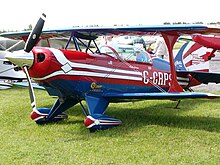From the Acrocamp blog:
"Three aircraft will serve as the training platforms for the project. The first two, an American Champion Citabria and an American Champion Super Decathlon, are aerobatically-certified light aircraft that seat two pilots in tandem (the student in front and the instructor in back). Each is commonly used to teach basic aerobatics and to teach pilots how to fly a tailwheel airplane."
 First, an American Champion Citabria:
First, an American Champion Citabria:The Citabria is a light single-engine, two-seat, fixed conventional gear airplane which entered production in the United States in 1964. Designed for flight training, utility, and personal use, it is capable of sustaining aerobatic stresses from +5g to -2g. Its name, "airbatic" spelled backward, reflects this.
If you're interested my google search for this airplane brought up a story in AOPA's Never Again. A good little read about checking the weather and how ATC can help a pilot out.
Next the American Champion Super Decathlon.

The Super Decathlon is a two-seat fixed conventional gear light airplanes designed for flight training and personal use and capable of sustaining aerobatic stresses between +6g and -5g. The Decathlon entered production in the United States in 1970 as a more powerful and stronger complement to the Citabria line of aircraft.
Interestingly enough, Steve Fossett was flying a Bellanca-built Super Decathlon when he went missing on September 3, 2007. He took off from an airstrip at William Barron Hilton's Flying-M Ranch, about 70 miles (110 km) southeast of Reno, Nevada. Remains of the plane were found 13 months later near the town of Mammoth Lakes, California, just south of the original search area.
The Acrocamp blog continues:
Most small airplanes in use today are so-called “tricycle-gear” airplanes because they have two main wheels and the third wheel is on the nose, in front of the mains. Tailwheel airplanes have the third wheel far behind the mains, on the tail, and are often referred to as “taildraggers” for obvious reasons. It’s much harder to take off and land in a taildragger (in fact, the FAA requires that a pilot have a special endorsement in his or her logbook before acting as pilot in command of a taildragger). Most aerobatic airplanes are taildraggers.
The third aircraft is slated to be a Pitts S-2B normally operated by Berz Flight Training (www.berzflighttraining.com) at Ray Community Airport west of New Haven. The Pitts is a taildragger like the Citabria and the Super Decathlon but, unlike the other two, it is a biplane that has two sets of wings – one on top and the other below. The Pitts is purpose-built for aerobatics, it can perform more extreme maneuvers, and it will serve as the advanced training platform beginning on the third day of the camp.
 The Pitts Special is a light aerobatic biplane designed by Curtis Pitts. It has accumulated many competition wins since its first flight in 1944. The Pitts Special dominated world aerobatic competition in the 1960s and 1970s and, even today, remains a potent competition aircraft in the lower categories.
The Pitts Special is a light aerobatic biplane designed by Curtis Pitts. It has accumulated many competition wins since its first flight in 1944. The Pitts Special dominated world aerobatic competition in the 1960s and 1970s and, even today, remains a potent competition aircraft in the lower categories. - Specifically an S-2B is an Aerotek-built S-2A with a 260 hp (194 kW) Lycoming AEIO-540-D4A5 engine, and upper wing auxiliary fuel tank, the landing gear and upper wings were moved forward six inches; 196 built. The aircraft is out of production but is supported by Aviat Aircraft.
I found a YouTube video of Aerobatics in a Pitts S-2B to Pink Floyd's "Learning to Fly"
I've been joking about practicing for this Acrocamp by standing on my head. I think I might actually have to do it; couldn't hurt. We were told to read Basic Aerobatics by Geza Szurovy and Mike Goulian as homework. Maybe there will be tips in there that'll help... though I'm relatively sure you can't scream and throw up at the same time [I'm also sure which one will win out].
No need to scream or throw up. The Super Decathlon is a delight to learn and fly aerobatics in and the Pitts is awesome. They'll need to surgically remove the grin from your face by the time you're done. Enjoy!
ReplyDelete